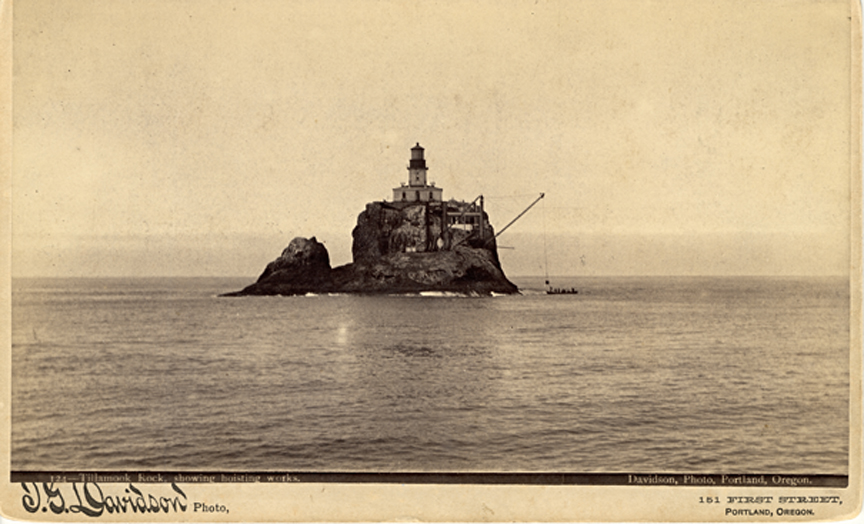Photographer I.G. Davidson produced this image of the Tillamook Rock Lighthouse in about 1885. The photograph depicts the 62-foot lighthouse tower atop Tillamook Rock, a basalt island off the Pacific Coast approximately twenty miles south of the Columbia River's entrance. Also visible is a small craft, full of people and supplies, and a derrick, hoisting equipment used to transport workers and goods from the vessel to the rock. While the photograph illustrates the size and isolation of the lighthouse, the calm waters of the Pacific Ocean belie the severe weather conditions lighthouse operators endured during the station's seventy-six years of operation.
In 1875, the Cape Disappointment and Point Adams lighthouses lit the northern and southern entrances to the Columbia River. No light existed farther south along the coast to warn northbound vessels that they were approaching the river's mouth. Congress appropriated $50,000 for this purpose in 1878. Early surveyors suggested that the lighthouse's proposed location, atop Tillamook Head, was not ideal because fog frequently obscured the 1000-foot bluff. Engineers determined that the 133-foot island below would provide better light, but the question remained if it was possible to erect a lighthouse atop a rock that protruded so dramatically from the sea.
Despite the drowning of one of the rock's earliest surveyors, the U.S. Light House Board ordered the U.S. Corps of Engineers to begin construction on the lighthouse in 1879. It proved to be a harrowing task. In addition to the island being awkward and dangerous to reach, storms sent powerful waves crashing on the rock. Severe weather in January 1880, for instance, demolished the crew's storehouse and left workers with little food or water for longer than two weeks.
In spite of these challenges, workers blasted a level base on which to build by May 1, 1880. On January 21, 1881, the Tillamook Rock Lighthouse shone for the first time, and the impressive structure soon gained acclaim as a significant achievement in engineering. Tillamook Rock served as an important aid to navigation until 1957, when the Coast Guard replaced it with an offshore buoy. The former lighthouse was listed on the National Register of Historic Places in 1981. Today the restored building houses ashes of the deceased; a private company, Eternity at Sea, operates it as a columbarium.
Further reading:
Gibbs, James A. Pacific Graveyard: A Narrative of Shipwrecks Where the Columbia Meets the Pacific Ocean. Portland: Binfords & Mort, 1964.
Written by Sara Paulson, © Oregon Historical Society, 2007.
